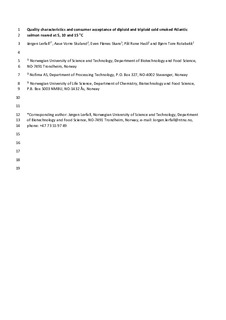| dc.contributor.author | Lerfall, Jørgen | |
| dc.contributor.author | Skuland, Aase Vorre | |
| dc.contributor.author | Skare, Even Flønes | |
| dc.contributor.author | Hasli, Pål Rune | |
| dc.contributor.author | Rotabakk, Bjørn Tore | |
| dc.date.accessioned | 2018-01-02T08:25:11Z | |
| dc.date.available | 2018-01-02T08:25:11Z | |
| dc.date.created | 2017-09-18T11:21:30Z | |
| dc.date.issued | 2017 | |
| dc.identifier.citation | Lebensmittel-Wissenschaft + Technologie. 2017, 85 (Part A), 45-51. | nb_NO |
| dc.identifier.issn | 0023-6438 | |
| dc.identifier.uri | http://hdl.handle.net/11250/2473881 | |
| dc.description.abstract | This study determined the processing characteristics, textural and colorimetric properties, NaCl content and consumer's acceptability of dry salted cold smoked triploid Atlantic salmon (average weight of 1.6 ± 0.3 kg) reared at different temperatures (5, 10 and 15 °C). As a reference, diploid siblings kept and processed under equal conditions was used. Ploidy did not affect the raw material biometrics but increased holding temperature gave increased blood lactate and decreased muscle pH at point of death. Triploid Atlantic salmon was found to be suitable for cold smoke processing but the differences in quality between diploid and triploid was significant. Cold smoked triploid salmon have on average lower processing yield, higher weight loss throughout processing and storage, and was softer as compared to diploids. Ploidy did however not affect the NaCl content. A consumer test did also distinguish between cold smoked diploid and triploid salmon originally kept at 10 °C. In addition, increased holding temperature was found to give a step-wise lower weight loss during processing and significant darker fillets after cold smoking and storage. | nb_NO |
| dc.language.iso | eng | nb_NO |
| dc.publisher | Elsevier | nb_NO |
| dc.title | Quality characteristics and consumer acceptance of diploid and triploid cold smoked Atlantic salmon reared at 5, 10 and 15 C | nb_NO |
| dc.type | Journal article | nb_NO |
| dc.description.version | submittedVersion | nb_NO |
| dc.source.pagenumber | 45-51 | nb_NO |
| dc.source.volume | 85 | nb_NO |
| dc.source.journal | Lebensmittel-Wissenschaft + Technologie | nb_NO |
| dc.source.issue | Part A | nb_NO |
| dc.identifier.doi | 10.1016/j.lwt.2017.06.055 | |
| dc.identifier.cristin | 1494723 | |
| dc.relation.project | Norges forskningsråd: 233689 | nb_NO |
| dc.relation.project | Nofima AS: 10803 | nb_NO |
| dc.description.localcode | This is a submitted manuscript of an article published by Elsevier Ltd in LWT - Food Science and Technology, 26 June 2017. | nb_NO |
| cristin.unitcode | 194,66,15,0 | |
| cristin.unitname | Institutt for bioteknologi og matvitenskap | |
| cristin.ispublished | true | |
| cristin.fulltext | preprint | |
| cristin.qualitycode | 1 | |
